|

COCORAHS RAIN GAUGE RALLY 2025 FINAL RESULTS - MINNESOTA (378) WINS THE TRADITIONAL CATEGORY FOR THE SIXTH YEAR IN A ROW . . . WYOMING THE PER CAPITA ! 1196 NEW VOLUNTEER OBSERVERS HAVE JOINED THE NETWORK DURING MARCH!
FINAL STANDINGS
Total Station Count: 1,193
|
Minnesota
| 378 |
1
| 66.12 |
2
| 5.72 |
|
Wisconsin
| 93 |
2
| 15.78 |
4
| 5.89 |
|
Texas
| 65 |
3
| 2.16 |
25
| 30.03 |
|
Michigan
| 62 |
4
| 6.18 |
9
| 10.03 |
|
Tennessee
| 53 |
5
| 7.52 |
7
| 7.05 |
|
Wyoming
| 52 |
6
| 89.44 |
1
| 0.58 |
|
North Carolina
| 41 |
7
| 3.83 |
13
| 10.70 |
|
Ohio
| 37 |
8
| 3.15 |
15
| 11.76 |
|
Pennsylvania
| 34 |
9
| 2.62 |
23
| 12.97 |
|
California
| 32 |
10
| 0.82 |
44
| 39.03 |
|
Florida
| 29 |
11
| 1.30 |
34
| 22.24 |
|
Illinois
| 23 |
12
| 1.83 |
28
| 12.58 |
|
Virginia
| 23 |
12
| 2.65 |
22
| 8.68 |
|
Massachusetts
| 22 |
14
| 3.15 |
15
| 6.98 |
|
Kentucky
| 20 |
15
| 4.43 |
11
| 4.51 |
|
New Mexico
| 19 |
16
| 8.99 |
6
| 2.11 |
|
Colorado
| 18 |
17
| 3.08 |
18
| 5.84 |
|
South Dakota
| 17 |
18
| 18.68 |
3
| 0.91 |
|
Indiana
| 15 |
19
| 2.20 |
24
| 6.83 |
|
Iowa
| 12 |
20
| 3.75 |
14
| 3.20 |
|
Nebraska
| 11 |
21
| 5.59 |
10
| 1.97 |
|
Missouri
| 11 |
21
| 1.78 |
29
| 6.18 |
|
Kansas
| 9 |
23
| 3.06 |
19
| 2.94 |
|
Mississippi
| 9 |
23
| 3.06 |
19
| 2.94 |
|
New Jersey
| 9 |
23
| 0.97 |
39
| 9.26 |
|
Washington
| 8 |
26
| 1.03 |
35
| 7.79 |
|
New York
| 8 |
26
| 0.41 |
49
| 19.68 |
|
Alabama
| 7 |
28
| 1.38 |
31
| 5.07 |
|
West Virginia
| 7 |
28
| 3.94 |
12
| 1.78 |
|
Arkansas
| 6 |
30
| 1.97 |
27
| 3.05 |
|
South Carolina
| 5 |
31
| 0.95 |
40
| 5.28 |
|
Arizona
| 5 |
31
| 0.68 |
47
| 7.36 |
|
North Dakota
| 5 |
31
| 6.42 |
8
| 0.78 |
|
Connecticut
| 5 |
31
| 1.38 |
31
| 3.63 |
|
Georgia
| 4 |
35
| 0.37 |
50
| 10.91 |
|
Louisiana
| 4 |
35
| 0.87 |
43
| 4.59 |
|
Oklahoma
| 4 |
35
| 1.00 |
37
| 4.02 |
|
Utah
| 3 |
38
| 0.89 |
41
| 3.38 |
|
Oregon
| 3 |
38
| 0.71 |
45
| 4.24 |
|
Canada
| 3 |
38
| 0.08 |
53
| 39.29 |
|
New Hampshire
| 3 |
38
| 2.15 |
26
| 1.40 |
|
Rhode Island
| 3 |
38
| 2.74 |
21
| 1.09 |
|
Maine
| 2 |
43
| 1.44 |
30
| 1.39 |
|
Idaho
| 2 |
43
| 1.03 |
35
| 1.94 |
|
Vermont
| 2 |
43
| 3.09 |
17
| 0.65 |
|
Puerto Rico
| 2 |
43
| 0.62 |
48
| 3.22 |
|
Maryland
| 2 |
43
| 0.32 |
51
| 6.16 |
|
Nevada
| 1 |
48
| 0.31 |
52
| 3.18 |
|
Hawaii
| 1 |
48
| 0.69 |
46
| 1.44 |
|
Montana
| 1 |
48
| 0.89 |
41
| 1.12 |
|
Delaware
| 1 |
48
| 0.98 |
38
| 1.02 |
|
Virgin Islands
| 1 |
48
| 9.61 |
5
| 0.10 |
|
Alaska
| 1 |
48
| 1.36 |
33
| 0.73 |
|
Bahamas
| 0 |
54
| 0.00 |
54
| 0.41 |
|
Guam
| 0 |
54
| 0.00 |
54
| 0.17 |
|
Northern Mariana Islands
| 0 |
54
| 0.00 |
54
| 0.05 |
|
District of Columbia
| 0 |
54
| 0.00 |
54
| 0.67 |

View the "CoCoRaHS Rain Gauge Rally 2025" trailer
THE ANNUAL COCORAHS RAIN GAUGE RALLY
Welcome to the CoCoRaHS Rain Gauge Rally Page. The CoCoRaHS Rain Gauge Rally is our friendly recruiting contest to see who can recruit the most new volunteers during the 31 days of March. CoCoRaHS 2025 Rain Gauge Rally . . . like the new name? After testing out "Precipitation Absurdity" last year, the votes were in and the name had to go. So this year we had several suggestions and chose Rain Gauge Rally, as that is what we are hoping for each March, more rain gauges in the field. The name actually states our intent.
There is always a need for a greater number of observations, as the saying goes "the rain doesn't fall the same on all". Due to the variability of precipitation, amounts measured can be quite different only a block or two away. Help fill in the gaps by recruiting a friend or relative during our contest. The more observations, the clearer the picture, the better the understanding of where it did and did not rain.
The contest is broken down into two categories: "Traditional Count" . . . the state/country/commonwealth that recruits the greatest number of new observers in March. The second category is "Per Capita*" or population weighted . . . the state/country/commonwealth that recruits the greatest number of new observers per one million of its total population.
The winning state/country/commonwealthin each category receives the "CoCoRaHS Cup" to keep and exhibit for a year until next year's contest (in the tradition of the NHL's Stanley Cup). The cup usually travels around the state/country/commonwealthduring the year, so check with your state/country/commonwealthcoordinator for it's whereabouts at any certain time.
HISTORY
View the past cup winners (2006 - 2024) 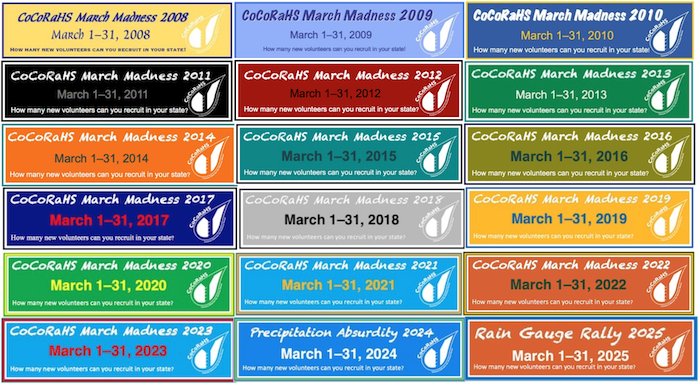
VIEWING THE COCORAHS CUP
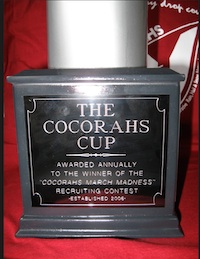 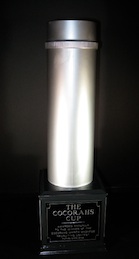 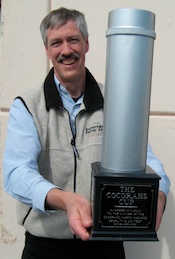
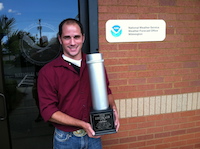 
 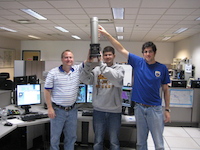  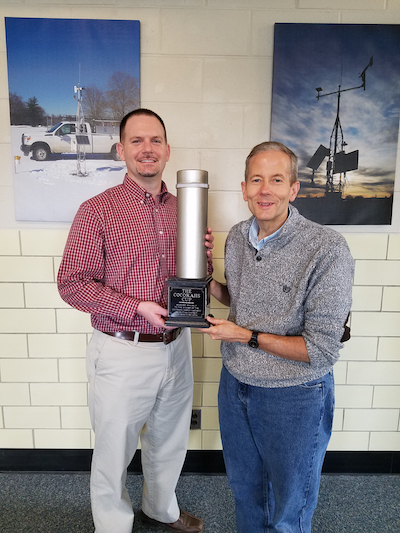  
 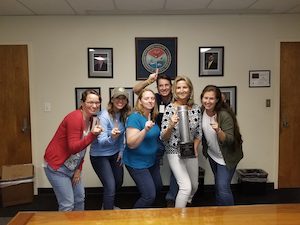
The CoCoRaHS Cup - Does it look like a sterling silver rain gauge? Tiffany's would be proud.
*Per Capita Scoring - For each new volunteer who signs-up, the state/country/commonwealth will be given a percentage of "one point" based on their total population (potential volunteer pool). This will give those with sparser populations an equal chance. Those with smaller populations will receive a larger point value for a new volunteer compared to those with larger populations (For each new volunteer Wyoming will receive 1.72 points based on their population of 581,311 residents, whereas California who will receive a much lower number of points per each new volunteer, 0.03 with their population of 39,029,342 residents). These point values are based on "new stations per million residents" which is derived from the 2024 estimated population information (https://www.census.gov.)
|